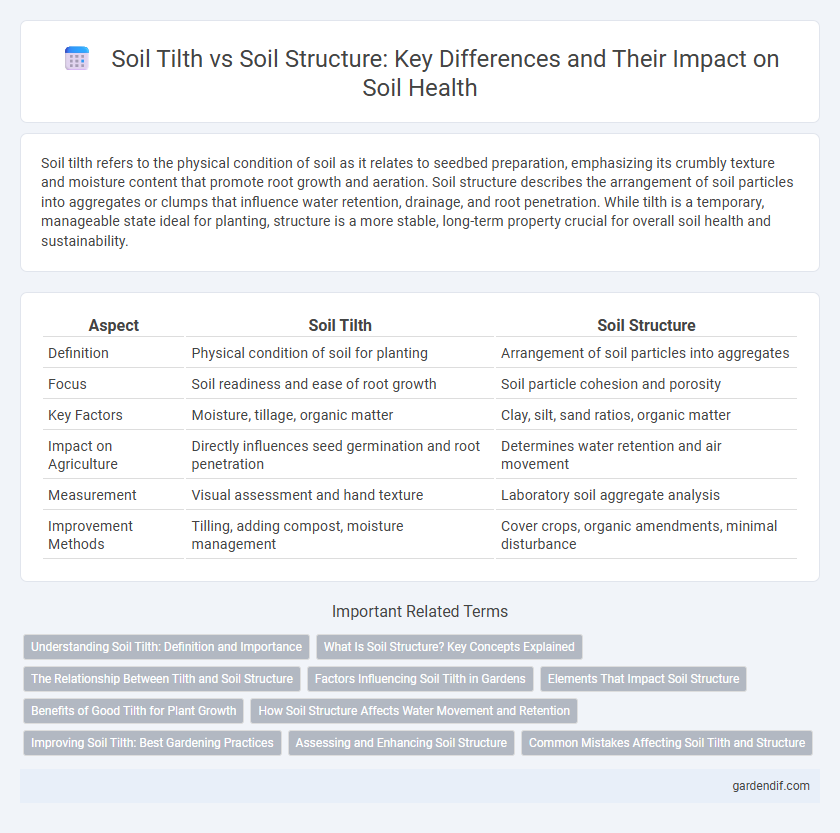
Tilth vs Structure Illustration
Soil tilth refers to the physical condition of soil as it relates to seedbed preparation, emphasizing its crumbly texture and moisture content that promote root growth and aeration. Soil structure describes the arrangement of soil particles into aggregates or clumps that influence water retention, drainage, and root penetration. While tilth is a temporary, manageable state ideal for planting, structure is a more stable, long-term property crucial for overall soil health and sustainability.
Table of Comparison
| Aspect | Soil Tilth | Soil Structure |
|---|---|---|
| Definition | Physical condition of soil for planting | Arrangement of soil particles into aggregates |
| Focus | Soil readiness and ease of root growth | Soil particle cohesion and porosity |
| Key Factors | Moisture, tillage, organic matter | Clay, silt, sand ratios, organic matter |
| Impact on Agriculture | Directly influences seed germination and root penetration | Determines water retention and air movement |
| Measurement | Visual assessment and hand texture | Laboratory soil aggregate analysis |
| Improvement Methods | Tilling, adding compost, moisture management | Cover crops, organic amendments, minimal disturbance |
Understanding Soil Tilth: Definition and Importance
Soil tilth refers to the physical condition of soil as it relates to plant growth, emphasizing its texture, structure, and moisture content. Good soil tilth ensures optimal aeration, water retention, and root penetration, essential for healthy crop development and soil fertility. Understanding soil tilth helps farmers and gardeners manage soil amendments and cultivation practices to enhance productivity and sustainability.
What Is Soil Structure? Key Concepts Explained
Soil structure refers to the arrangement of soil particles into aggregates or clumps, influencing aeration, water retention, and root penetration. Key concepts include the size and shape of aggregates, which determine pore space and soil stability, essential for healthy plant growth. Understanding soil structure helps optimize soil tilth, improving nutrient availability and resilience against erosion.
The Relationship Between Tilth and Soil Structure
Tilth refers to the physical condition of soil as it relates to its suitability for planting and crop growth, heavily influenced by soil structure, which is the arrangement of soil particles into aggregates. Well-developed soil structure promotes optimal tilth by improving aeration, water infiltration, and root penetration, enabling healthy plant development. Poor soil structure can lead to compaction and crusting, significantly degrading tilth and hindering soil productivity.
Factors Influencing Soil Tilth in Gardens
Soil tilth in gardens is influenced by factors such as organic matter content, soil texture, moisture levels, and microbial activity, which together determine soil aeration and nutrient availability. The presence of earthworms and soil biota enhances aggregation, improving crumb structure essential for root penetration. Proper management practices like avoiding compaction, incorporating compost, and maintaining balanced pH levels promote optimal tilth and sustainable garden health.
Elements That Impact Soil Structure
Soil structure is directly influenced by organic matter content, microbial activity, and the presence of soil aggregates, which improve porosity and water retention. Mineral particles such as sand, silt, and clay affect soil texture, shaping its ability to retain nutrients and air. Soil management practices, including tillage, cover cropping, and organic amendments, significantly impact the development and stability of soil tilth and structure.
Benefits of Good Tilth for Plant Growth
Good tilth enhances soil aeration, promoting efficient root respiration and nutrient uptake essential for robust plant growth. Optimal tilth improves water infiltration and retention, ensuring consistent moisture availability while minimizing erosion and runoff. A well-tilled soil structure supports beneficial microbial activity, which stabilizes nutrient cycling and boosts overall soil fertility.
How Soil Structure Affects Water Movement and Retention
Soil structure directly influences water movement and retention by determining pore size and connectivity, which control infiltration rates and moisture availability. Well-aggregated soil with stable tilth enhances water retention by creating optimal pores for holding water while allowing excess to drain, promoting healthy root growth. Poor soil structure with compacted or cloddy particles reduces infiltration, increases runoff, and limits water retention, negatively impacting plant health and soil aeration.
Improving Soil Tilth: Best Gardening Practices
Improving soil tilth involves enhancing the soil's physical condition to promote root growth, aeration, and drainage, which directly impacts plant health. Techniques such as regular organic matter incorporation, cover cropping, and minimizing soil compaction create a crumbly, friable soil texture that supports microbial activity and nutrient availability. Proper tillage methods combined with mulch application maintain soil structure while fostering optimal moisture retention and reducing erosion.
Assessing and Enhancing Soil Structure
Assessing soil structure involves examining soil aggregates, porosity, and compaction levels to determine its capacity for water retention and root penetration. Enhancing soil structure can be achieved through organic matter incorporation, reduced tillage, and cover cropping to promote microbial activity and aggregate stability. Improved soil structure supports nutrient cycling, reduces erosion, and fosters healthy plant growth by optimizing air and moisture exchange.
Common Mistakes Affecting Soil Tilth and Structure
Overworking soil by frequent tilling disrupts soil structure, leading to compaction and poor tilth, which reduces aeration and water infiltration. Ignoring organic matter incorporation limits microbial activity, resulting in weak soil aggregates and diminished soil fertility. Neglecting proper moisture management causes soil crusting and erosion, further degrading both soil structure and tilth.
Tilth vs Structure Infographic

 gardendif.com
gardendif.com